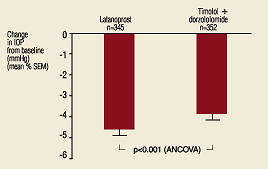Latanoprost gives alternative to combined therapy
Monotherapy is as effective as two-drug combination, study shows.
LONDON — Latanoprost (Xalatan; Pharmacia Corporation) monotherapy once daily can be an alternative to combined treatments, concluded Alain M. Bron, MD, of Dijon, France.
He reported on a study comparing the safety and efficacy of Xalatan given alone with timolol and dorzolamide twice daily.
Dr. Bron compared the safety and efficacy of adding dorzolamide to timolol, or of switching to monotherapy. He and other researchers conducted a meta-analysis of five multicenter, randomized, observer-masked, 3-month trials all performed in European countries.
He reported on the study results at the European Glaucoma Society meeting held here.
“The most important conclusion is the equivalence at 3 months of both treatments as far as intraocular pressure [IOP] reduction is concerned,” Dr. Bron told Ocular Surgery News. “We can conclude that in patients insufficiently controlled with timolol 0.5% twice per day, a switch to Xalatan alone leads to the same magnitude of IOP reduction than adding dorzolamide twice per day to timolol twice per day. A longer follow-up would be mandatory.”
Meta-analysis done
DIURNAL IOP REDUCTION AT 3 MONTHS  ---All patients were 18 years or older and inadequately controlled on beta-andrenergic receptor antagonists.
---All patients were 18 years or older and inadequately controlled on beta-andrenergic receptor antagonists.
All patients had primary open-angle glaucoma (POAG) with IOP greater than or equal to 22 mm Hg, or had ocular hypertension greater than or equal to 27 mm Hg. All patients took one or two hypotensive drugs, of which one was a beta-adrenergic receptor.
Patients underwent a washout period in which they received timolol for between 2 and 4 weeks. Then, 345 patients were switched to latanoprost 0.005% once daily, and 352 added dorzolamide 2% twice daily.
The diurnal IOP was calculated as a mean of three daytime readings. The latanoprost group had a mean age of 63.3 ±12.6 years, with a range of 24 to 95. The combination therapy group had a mean age of 64.1 ±12.1 years, with a range of 20 to 93.
Of the 697 patients, four were Asian, five were black and the remainder were white. In the group, 583 had POAG, 51 had capsular glaucoma, 58 had ocular hypertension and the remainder had other conditions or a combination of conditions.
Latanoprost advantages
Next, 23 patients were withdrawn from analysis because of adverse events, uncontrolled IOP, a failure to meet inclusion criteria or other reasons. Statistical analysis was done by Pharmacia employee Katarina Hedman.
At 3 months, the diurnal IOP reduction was 4.8 ±0.2 mm Hg in the latanoprost group and 4.1 ±0.2 mm Hg in the combination therapy group.
The difference was statistically significant in favor of latanoprost. A diurnal IOP of 18 mm Hg or less was achieved by 61% of latanoprost-treated patients, compared with 46% of combination therapy patients. A reduction of 20% or more from baseline was achieved by 54% of latanoprost patients, compared with 44% of patients treated with combination therapy. Adverse events were recorded. In the latanoprost group, 27 experienced eye irritation, 13 had hyperemia and none had taste perversion. In the combination group, 55 had eye irritation, six had hyperemia and six had taste perversion.
For Your Information:
- Alain M. Bron, MD, can be reached at the Service D’ Ophthalmologie, Hopital General CHU, Dijon 21000 France; (33) 380-293-756; fax: (33) 380-293-589. Dr. Bron has no direct interest in any products mentioned in this article. He is a paid consultant for Pharmacia.
- Pharmacia Corporation can be reached at 100 Route 206 N, Peapack, NJ 07977; (908) 901-8517; fax: (908) 901-1874.
